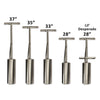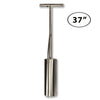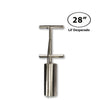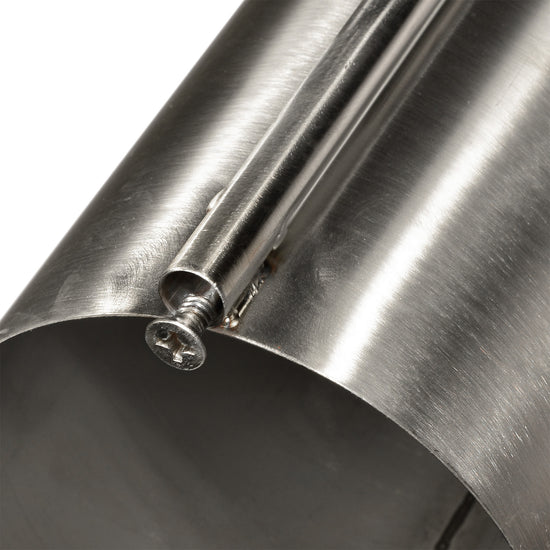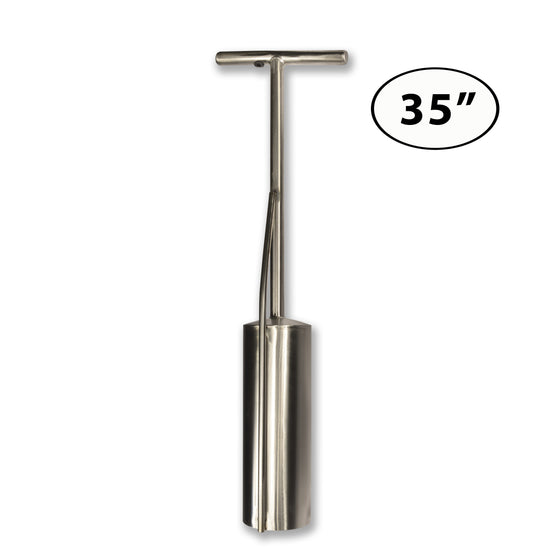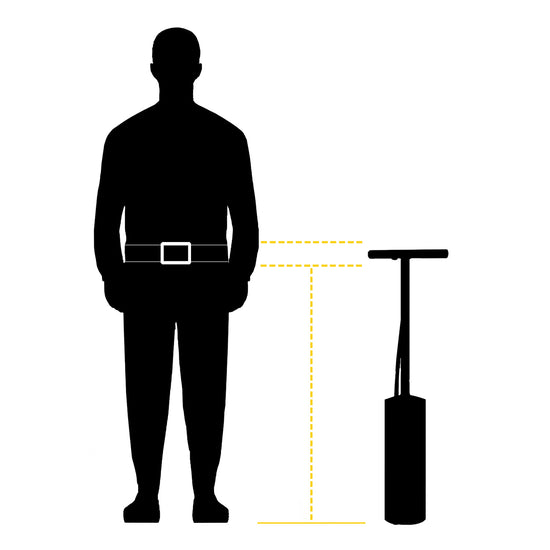












Murff’s Claminator™ Stainless Steel Clam Gun
Our clam guns are truly built by clammers, for clammers. We have worked hard to build the best, most reliable clam guns you can buy. They are made of the finest stainless steel to offer maximum protection against sea water, and every-day wear and tear. Perfect for digging razor and gapper clams!
People come in all different sizes, and so do our clam guns. We offer three different sizes for adults to make sure you are getting the most efficient and comfortable tool for your particular height. See our sizing chart and recommendations below.
Our 28" clam guns are designed specifically for young kids. They come with a shorter, 12" barrel and our Lil' Desperado version features foot pegs to help your little clammers get all of their weight on the gun to get it down into the sand.
SHIPPING
We offer the discounted flat rate of $5.00 for ground shipping of our standard clam gun products for customers located in WA and OR. All other states in the continental US (does not include Alaska or Hawaii) will be charged the discounted flat rate of $9.50. For customers in Alaska, please reach out to us via the contact form for a custom shipping quote.
Please contact us to ask about expedited shipping options. We can also ship our products globally and we are happy to provide a shipping quote for your desired destination. Please write us via the contact form to request a quote for shipping options.
PICKUP ORDERS
We do not have a retail location. All pickup orders are by appointment only and must be scheduled in advance with Dale Murff. Please contact Dale prior to purchasing at dale@theclaminator.com to coordinate a pickup time. Customers must also bring proof of purchase.
CHECK LOCAL REGULATIONS
Please check the clamming rules and regulations in your area to ensure that clam guns are legal for harvesting shellfish. Some states and municipalities on the east coast (i.e. MA, NH, ME) may have restrictions on the use of certain devices or handle length.
| SIZES | RECOMMENDED |
|---|---|
| for the taller digger 5’11” and taller | |
| for 5’6″ – 5’10″ diggers | |
| for 5′ – 5’5″ diggers | |
| for kids as young as 8 years old | |
| We offer a variety of custom guns for specialty needs or personal preference including: custom sizes, oval clam guns, as well as horseneck clam and geoduck specific guns. Use the contact form or send us an email and tell us what you are looking for. |
We recommend that the handle of your clam gun be about "belt buckle" height. To find your size, measure from the ground to your belt buckle.

| FEATURES | SPECS |
|---|---|
| Materials | |
| Barrel Diameter | |
| Barrel Length | |
| Barrel Length | |
| T-Handle | |
| Handle Vent Hole | |
| Vent Tube | |
| Weight | |
| Warranty | |
| MSRP |
Occasionally, we get questions from customers about problems they are having with their valve getting stuck in the closed position. We have created a FAQ page to address many of these issues and to offer some solutions.
First off, There is a wide range of sand consistencies. Drier sand tends to adversely affect the valve action efficiency. To prevent your clam gun valve from getting stuck or clogging up with sand you should frequently (every hole or two) rinse the valve in the surf or a tide pool and give it an occasional little twist/shake to let the valve rattle around. This will help to keep the vent tube clear and prevent it from clogging up.
You may occasionally find that valve is stuck in the closed position. (This is quite easy to determine because it means the vent tube will not be working and the clam gun will be much harder to pull a core out of the sand). Try rinsing the valve in the surf or a tide pool. If that doesn’t work to free the valve, try laying the clam gun down, horizontally in the surf or a side pool, allowing water to enter the top of the vent tube to “flush” the valve clean. Again, give the gun a little twist/shake and listen for the rattle, insuring the valve is operating correctly.
If the above methods do not work to free the valve, the next step is to carefully pry the valve open. Sometimes this can be accomplished with just a fingernail. You can also use a small flat-head screw driver or pocket knife to gently pry it open. Once free, rinse thoroughly in the surf or a tide pool to clean out any remaining sand.
Upon inspection of a few guns returned due to claims of valve defect. I have found most of them had dried sand in the vent tube and with a rinse and a few taps, it freed the sand and the gun was completely operable.
Again, please check out the FAQ page for more information and solutions.
CAUTION: Although the valve has a Phillips (cross) head, it is not designed to be twisted or unscrewed. By doing so, you risk breaking off the rivet that is holding it in place.
Years ago we built a custom clam gun, with a longer barrel, for a gentleman that lived near Mocrocks Beach near Moclips, WA. We called subsequent custom builds like this design our "Mocrocks" gun. When we decided to launch this new design as a regular production model we chose to keep the name we have been affectionately calling it for all these years.
But where (you may ask) does the word Mocrocks come from? We wondered the same thing. According to David Berger’s book, "Razor Clams – Buried Treasure of the Pacific Northwest":
[Mocrocks]…management area, is a mash-up that was created by state authorities when they devised the management areas. Mocrocks is neither English nor Native, but a Franken-word. Authorities combined the “Moc” of Moclips, the city marking the areas northern boundary – and dividing the work oddly since it's pronounced MO-clips with the “rocks” of Copalis Rocks, the feature marking the southern boundary.
Mockrocks. Most people pronounce this as “Mock-Rocks” equal emphasis on both syllables, so it sounds more like and incantation than a location.
And now you know...as much as we do!
(A special thank you to Justine James with the Quinault Indian Nation for helping us track down the etymology of the word Mocrocks.)


